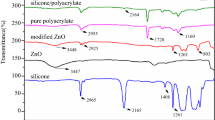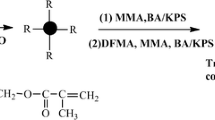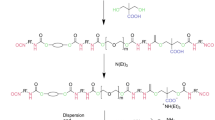Abstract
Novel eco-friendly sulfonated polyurethane/polyacrylate (SPUA) emulsions were synthesized by surfactant-free emulsion polymerization method using PU as seeds. The sodium sulfonate modified polyester polyol (SDNP) was used as internal emulsifier to make the PU emulsion disperse in deionized water. Effects of the SDNP content on the properties of the emulsions and membranes were studied. Dynamic light scattering (DLS) result showed that the average particle sizes of SPUA emulsions decreased first from 124.1 nm to 102 nm when the SDNP content was lower than 40 wt% and then increased to 138 nm. Transmission electron microscopy (TEM) morphology showed that the particle sizes were all spherical and an apparent core-shell structure was observed. Fourier transform infrared spectroscopy (FT-IR) result ascertains that SPUA was successfully prepared. X-ray photoelectron spectroscopy (XPS) analysis demonstrates that the carbon, oxygen, nitrogen, sulfur, and sodium peaks were all revealed and the polyurethane component was rich in the upper surface. Thermo gravimetric analysis (TGA) of the membranes showed that the thermal stability of the SPUA membranes was enhanced by increasing the SDNP content. Scanning electron micrograph (SEM) results demonstrates that the coexistence of a dual phase. The SPUA could be used as adhesives in footwear industry, and the T-peel strength of the SPUA membranes increased from 5.98 N/mm to 12.06 N/mm when the SDNP content was up to 40 wt%. The wettability of SPUA emulsions on the rubber surface results showed that the emulsions could wet the rubber surface well.











Similar content being viewed by others
References
Földes E, Tóth A, Kálmán E, Fekete E, Tomasovszky–Bobák á (2000) Surface changes of corona-discharge-treated polyethylene films. J Appl Polym Sci 76(10):1529–1541.
Kim BK, Shin JH (2002) Modification of waterborne polyurethane by forming latex interpenetrating polymer networks with acrylate rubber. Colloid Polym Sci 280(8):716–724
Sundar S, Tharanikkarasu K, Dhathathreyan A, Radhakrishnan G (2002) Aqueous dispersions of poly(urethane-co-vinylpyridine) synthesised from polyurethane macroiniferter. Colloid Polym Sci 280(10):915–921
Lewandowski K, Krepski LR, Mickus DE., Roberts RR, S. Heilmann M, Larson WK, Purgett MD, Koecher SD, Johnson SA, McGurran DJ, Rueb CJ, Pathre SV, Thakur KAM (2002) Synthesis and properties of waterborne self-crosslinkable sulfo-urethane silanol dispersions. J Polym Sci, Polym Chem 40(17):3037–3045.
Lee HT, Wu SY, Jeng RJ (2006) Effects of sulfonated polyol on the properties of the resultant aqueous polyurethane dispersions. Colloid Surf A 276(1–3):176–185
Kim IH, Shin JS, Cheong IW, Kim JI, Kim JH (2002) Seeded emulsion polymerization of methyl methacrylate using aqueous polyurethane dispersion: effect of hard segment on grafting efficiency. Colloid Surf A 207(1–3):169–176
Wen TC, Tseng HS, Lu ZB (2000) Co-solvent effect on conductivity of composite electrolytes comprising polyethylene oxide and polytetramethylene glycol-based waterborne polyurethane via a mixture design approach. Solid State Ionics 134(3–4):291–301
Wang HL, Gopalan A, Wen TC (2003) A novel lithium single ion based polyurethane electrolyte for light-emitting electrochemical cell. Mater Chem Phys 82(3):793–800
Mequanint K, Sanderson R (2003) Nano-structure phosphorus-containing polyurethane dispersions: synthesis and crosslinking with melamine formaldehyde resin. Polymer 44(9):2631–2639
Nomula S, Cooper SL (2001) Ionomer solution structure and solution diagram. Macromolecules 34(8):2653–2659
Wang XR, Shen YD, Lai XJ (2014) Micromorphology and mechanism of polyurethane/polyacrylate membranes modified with epoxide group. Prog Org Coat 77(1):268–276
Wang XR, Shen YD, Lai XJ, Liu GJ, Du Y (2014) Micromorphology and thermal properties of polyurethane/polyacrylate soap-free emulsion in the presence of functional monomers. J Polym Res 21(3):367
Adler HJ, Jahny K, Vogt-Birnbrich B (2001) Polyurethane macromers-new building blocks for acrylic hybrid emulsions with outstanding performance. Prog Org Coat 43(4):251–257
Darwish MA, Machunsky S, Peuker U, Kunz U, Turek T (2011) Magnetite core-shell nano-composites with chlorine functionality: preparation by miniemulsion polymerization and characterization. J Polym Res 18(1):79–88
Xin H, Shen YD, Li XR (2011) Novel cationic polyurethane-fluorinated acrylic hybrid latexes: synthesis, characterization and properties. Colloid Surf A 384(1–3):205–211
Jang JY, Jhon YK, Cheong IW, Kim JH (2002) Effect of process variables on molecular weight and mechanical properties of water-based polyurethane dispersion. Colloid Surf A 196(2–3):135–143
Honarkar H, Barmar M, Barikani M (2016) New sulfonated waterborne polyurethane dispersions: preparation and characterization. J Disper Sci Technol 37(8):1219–1225
Athawale VD, Kulkarni MA (2010) Synthesis, characterization, and comparison of polyurethane dispersions based on highly versatile anionomer, ATBS, and conventional DMPA. J Coating Technol Res 7(2):189–199
Zhou XH, Tu WP, Hu JQ (2006) Preparation and characterization of two-component waterborne polyurethane comprised of water-soluble acrylic resin and HDI biuret. Chinese J Chem Eng 14(1):99–104
Xiao XY, Wang Y (2009) Emulsion copolymerization of fluorinated acrylate in the presence of a polymerizable emulsifier. Colloid Surf A 348(1–3):151–156
Sanchis MR, Calvo O, Fenollar O, Garcia D, Balart R (2008) Characterization of the surface changes and the aging effects of low-pressure nitrogen plasma treatment in a polyurethane film. Polym Test 27(1):75–83
Takahashi K, Nagai K (1996) Preparation of reactive polymeric microspheres by seeded copolymerization using a polymerizable surfactant bearing an active ester group. Polymer 37(7):1257–1266
Chattopadhyay DK, Sreedhar B, Raju KVSN (2005) Effect of chain extender on phase mixing and coating properties of polyurethane Ureas. Ind Eng Chem Res 44(6):1772–1779
Ramezanzadeh B, Ghasemi E, Mahdavian M, Changizi E, Mohamadzadeh Moghadam MH (2015) Characterization of covalently-grafted polyisocyanate chains onto graphene oxide for polyurethane composites with improved mechanical properties. Chem Eng J 281:869–883
Zhang SB, Jiang HM, Xu YM, Zhang DH (2007) Thermal and crystalline properties of water-borne polyurethanes based on IPDI, DMPA, and PEBA/HNA. J Appl Polym Sci 103(3):1936–1941
Coutinho FMB, Delpech MC, Alves TL, Ferreira AA (2003) Degradation profiles of cast films of polyurethane and poly(urethane-urea) aqueous dispersions based on hydroxy-terminated polybutadiene and different diisocyanates. Polym Degrad Stab 81(1):19–27
Pérez-Limiñana MA, Arán-Aís F, Torró-Palau AM, César Orgilés-Barceló A, Miguel Martín-Martínez J (2005) Characterization of waterborne polyurethane adhesives containing different amounts of ionic groups. Int J Adhes Adhes 25(6):507–517
Lei L, Xia ZB, Ou CB, Zhang L, Zhong L (2015) Effects of crosslinking on adhesion behavior of waterborne polyurethane ink binder. Prog Org Coat 88:155–163
Park DH, Oh JK, Kim SB, Kim WN (2013) Synthesis and characterization of sulfonated polyol-based waterborne polyurethane-polyacrylate hybrid emulsions. Macromol Res 21(11):1247–1253
Hu D, Li L, Li YX, Yang CF (2017) Restructuring the surface of polyurethane resin enforced filter media to separate surfactant stabilized oil-in-water emulsions via coalescence. Sep Purif Technol 172:59–67
Acknowledgements
This project was supported by the Graduate Innovation Fund of Shaanxi University of Science & Technology, and the authors would also like to thank the National Natural Science Foundation of China (contract grant number: 51373091), the specialized research fund of Xianyang Normal University Project (14XSYK014) for financial support.
Author information
Authors and Affiliations
Corresponding author
Rights and permissions
About this article
Cite this article
Ma, G., Shen, Y., Gao, R. et al. Micromorphology and adhesive properties of sulfonated polyurethane/polyacrylate emulsions prepared by surfactant-free polymerization. J Polym Res 24, 36 (2017). https://doi.org/10.1007/s10965-017-1200-0
Received:
Accepted:
Published:
DOI: https://doi.org/10.1007/s10965-017-1200-0




